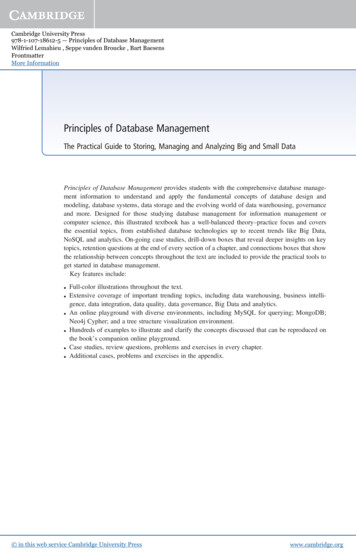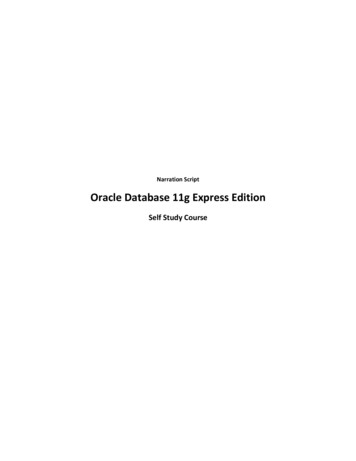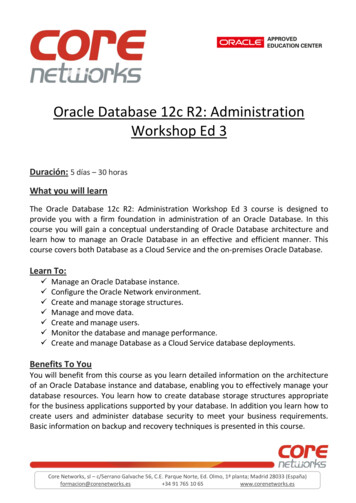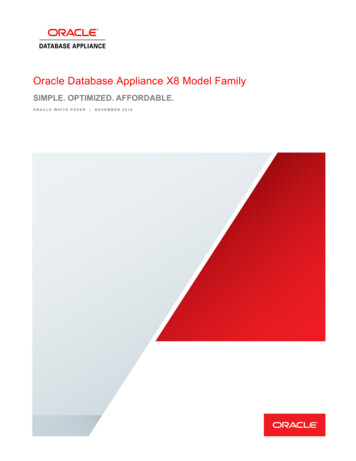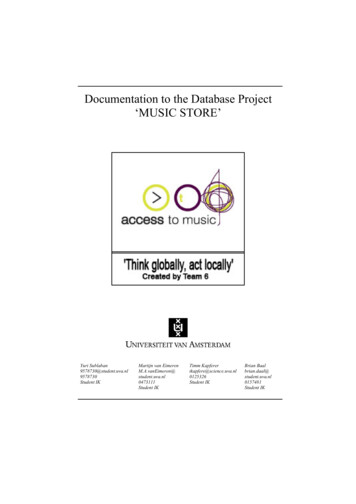
Transcription
CSE 544Principles of DatabaseManagement SystemsMagdalena Balazinska (magda)Winter 2009Lecture 1 - Class Introduction
Outline Introductions Class overview What is the point of a db management system (DBMS)? Main DBMS features and DBMS architecture overviewCSE 544 - Winter 20092
Course Staff Instructor: Magda (magda@cs.washington.edu)– Office hours by appointment– Location: CSE 550 TA: Evan Welbourne (evan@cs.washington.edu)– Graduate student in the database & ubicomp groups– Office hours: Monday 12pm-1pm Wednesday 9:30am - 10:30am By appointment– Location: CSE 405CSE 544 - Winter 20093
Who is Magda? Assistant Professor since January 2006 PhD from MIT, February 2006 Areas of interest: databases and systems Current research focus––––Cloud computingScientific data managementRFID data managementStream processingCSE 544 - Winter 20094
Goals of the Class Study principles of data management– Data models, data independence, normalization– Data integrity, availability, consistency, etc. Study key DBMS design issues– Storage, query execution and optimization, transactions– Distribution, parallel processing, massive data processing– Data warehousing, streaming data, etc. Ensure that––––You are comfortable using a DBMSYou can write applications that use a DBMS as a back-endYou have an idea about how to build a DBMSYou know a bit about current research topics in data managementCSE 544 - Winter 20095
Class Format Two lectures per week: MW @ 10:30am Mix of lecture and discussion– Mostly based on papers Must read papers before lecture and submit paper review– Come prepared to discuss the papers assigned for the class Class participation counts for a non-negligible part of your grade One guest lecture: David Lomet from Microsoft ResearchCSE 544 - Winter 20096
Readings and Notes Readings are based on papers––––Mix of old seminal papers and new papersPapers available online on class websiteMany come from the “red book” [optional]Three types of readings Mandatory, additional resources, and optional Background readings from the following book– Database Management Systems. Third Ed. Ramakrishnan andGehrke. McGraw-Hill. [recommended] Lecture notes (the ppt slides)– Posted on class website after each lectureCSE 544 - Winter 20097
Class Resources Website: lectures, assignments, projectshttp://www.cs.washington.edu/544List of all the deadlines Mailing list:cse544@cs.washington.eduMake sure you register!CSE 544 - Winter 20098
Evaluation Class participation 10%– Paper readings and discussions Paper reviews 5%: Individual– Due before each lecture– Reading questions are posted on class website Assignments 25%: Groups of two– HW1: Using a DBMS (SQL, views, indexes, etc.) & writing apps– HW2 & HW3: Building a simple DBMS Project 35%: Groups of two to four– Small research or engineering. Start to think about it now! Final exam 25%: During finals weekCSE 544 - Winter 20099
Class Participation An important part of your grade Because– We would like you to read and think about papers throughout thequarter– Important to learn to discuss papers Expectations– Ask questions, raise issues, think critically– Learn to express your opinion– Respect other people’s opinionsCSE 544 - Winter 200910
Paper reviews Between 1/2 page and 1 page in length– Summary of the main points of the paper– Critical discussion of the paper Reading questions– For some papers, we will post reading questions to help youfigure out what to focus on when reading the paper– Please address these questions in your reviews Grading: credit/no-credit– You can skip one review without penalty– MUST submit review BEFORE lecture– Individual assignments (but feel free to discuss paper with others)CSE 544 - Winter 200911
Assignments Goals:– Hands-on experience using a DBMS and writing apps for DBMS– Hands-on experience building a simple DBMS HW1: Check website for instructions and due date–––––Setup a db from scratchPractice writing SQL queries & browse the system catalogGet experience with integrity constraints & triggersPlay with indexes and viewsWriting an application that uses a db as a back-end HW2 & HW3: Build a simple DBMS We will accept late assignments with valid excuseCSE 544 - Winter 200912
Project Overview Topic–––––––Choose from a list of mini-research topicsOr come up with your ownCan be related to your ongoing researchCan be related to a project in another courseMust be related to databasesMust involve either research or significant engineeringOpen ended Final deliverables– Short conference-style paper (8 pages)– Conference-style presentationCSE 544 - Winter 200913
Project Goals Apply database principles to a new problem– Understand and model the problem– Research and understand related work– Propose some new approach Creativity will be evaluated– Implement some parts– Evaluate your solution– Write-up and present your results Amount of work may vary widely between groupsCSE 544 - Winter 200914
Project Milestones Jan 19th: teams formedFeb 2nd: project proposalFeb 20th: milestone reportMarch 11th: project presentationsMarch 13th: final project reports More details on the website, including ideas & examples We will meet with you regularly throughout the quarterCSE 544 - Winter 200915
Let’s get started What is a database? Give examples of databasesCSE 544 - Winter 200916
Let’s get started What is a database?– A collection of files storing related data Give examples of databases– Accounts database; payroll database; UW’s students database;Amazon’s products database; airline reservation databaseCSE 544 - Winter 200917
Data Management Data is valuable but hard and costly to manage Example: Store database– Entities: employees, positions (ceo, manager, cashier), stores,products, sells, customers.– Relationships: employee positions, staff of each store, inventoryof each store. What operations do we want to perform on this data? What functionality do we need to manage this data?CSE 544 - Winter 200918
Required Functionality1.2.3.Describe real-world entities in terms of stored dataCreate & persistently store large datasetsEfficiently query & update1.2.3.Must handle complex questions about dataMust handle sophisticated updatesPerformance matters4. Change structure (e.g., add attributes)5. Concurrency control: enable simultaneous updates6. Crash recovery7. Access control, security, integrityDifficult and costly to implement all these featuresCSE 544 - Winter 200919
Database Management System A DBMS is a software system designed to provide datamanagement services Examples of DBMS– Oracle, DB2 (IBM), SQL Server (Microsoft),– PostgreSQL, MySQL, CSE 544 - Winter 200920
Market Shares In 2004 (from www.computerworld.com)– IBM, 35% market with 2.5 billion in sales– Oracle, 33% market with 2.3 billion in sales– Microsoft, 19% market with 1.3 billion in salesCSE 544 - Winter 200921
Typical System Architecture“Two tier system” or “client-server”connection(ODBC, JDBC)Data filesDatabase server(someone else’sCCSEprogram)544 - Winter 2009Applications22
Main DBMS Features Data independence– Data model– Data definition language– Data manipulation language How to decide what featuresshould go into the DBMS?Efficient data accessData integrity and securityData administrationConcurrency controlCrash recoveryReduced application development timeCSE 544 - Winter 200923
A Quick Look Inside a DBMSAdmission ControlParserConnection MgrQuery RewriteOptimizerExecutorProcess ManagerQuery ProcessorAccess MethodsBuffer ManagerLock ManagerLog ManagerStorage ManagerCSE 544 - Winter 2009Memory MgrDisk Space MgrReplication ServicesAdmin UtilitiesShared Utilities[Anatomy of a Db System.J. Hellerstein & M. Stonebraker.24Red Book. 4ed.]
When not to use a DBMS? DBMS is optimized for a certain workload Some applications may need– A completely different data model– Completely different operations– A few time-critical operations Examples– Text processing– Scientific analysisCSE 544 - Winter 200925
Preview for Next LectureLevels of abstraction in a DBMSExternal Schemaviewsaccess controlExternal SchemaConceptual SchemaPhysical SchemaDiskCSE 544 - Winter 2009External Schemaa.k.a logical schemadescribes stored datain terms of data modelincludes storage detailsfile organizationindexes26
Principles of Database Management Systems Magdalena Balazinska (magda) Winter 2009 Lecture 1 - Class Introduction . CSE 544 - Winter 2009 Outline Introductions Class overview What is the point of a db management system (DBMS)? .File Size: 399KBPage Count: 26




